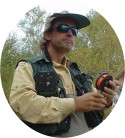The most critical will say this isn't a cast in its own right but rather a cast followed by a mend. I'd rather consider it a cast so I can make up a name and baptize a new cast. This is every fly-casting instructor's dream, a way to finally become famous and rich and be able to spend all your time fishing and teaching fly-casting. Seriously though, I prefer to consider it a cast in its own right because you have to execute the mend accurately, without pausing and with just the right force. Properly executed, this cast is a continuous, fluid and synchronized sequence of movements with no pause before the line finishes lying down on the water. That, in my opinion, is a good definition of cast.
Description
Depending on the direction of the roll cast after the parachute, the line creates angles in any direction and size in relation to the fly.
Use
To avoid dragging in complex situations of strong currents and weirs fishing upstream.
Execution
After a parachute cast, shoot line backward by simply letting line slip through the rings as you move the rod back to a vertical position pointing skywards. Just as the line barely touches the water, smoothly execute a roll cast with very controlled energy in any direction. The fly should stay exactly where it fell after the parachute.
If it doesn't come out right, it's because…
- You execute the roll cast too soon.
- You haven't understood the bit about shooting line backward.
- Your line doesn't slip well through the rings. Clean it, you dirty pig.
- You've applied too much force in the roll cast and lifted all the line off the water.


